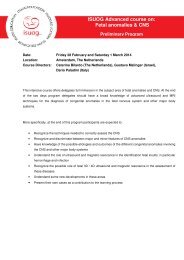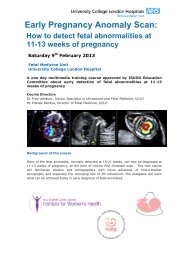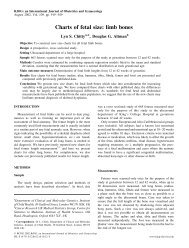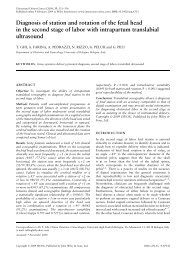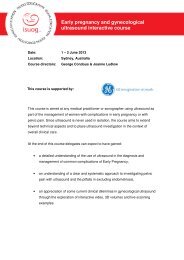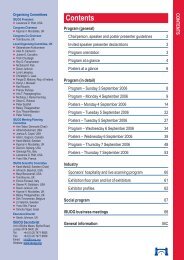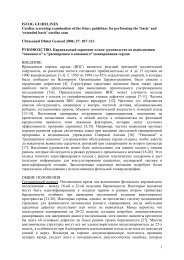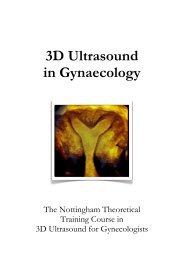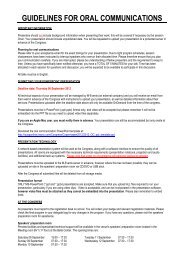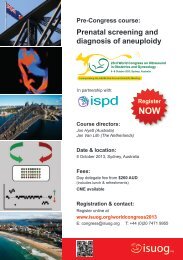(updated): sonographic screening examination of the fetal ... - isuog
(updated): sonographic screening examination of the fetal ... - isuog
(updated): sonographic screening examination of the fetal ... - isuog
Create successful ePaper yourself
Turn your PDF publications into a flip-book with our unique Google optimized e-Paper software.
Ultrasound Obstet Gynecol 2013; 41: 348–359Published online in Wiley Online Library (wileyonlinelibrary.com). DOI: 10.1002/uog.12403<strong>isuog</strong>.orgGUIDELINESISUOG Practice Guidelines (<strong>updated</strong>): <strong>sonographic</strong> <strong>screening</strong><strong>examination</strong> <strong>of</strong> <strong>the</strong> <strong>fetal</strong> heartClinical Standards CommitteeThe International Society <strong>of</strong> Ultrasound in Obstetricsand Gynecology (ISUOG) is a scientific organization thatencourages safe clinical practice and high-quality teachingand research related to diagnostic imaging in women’shealthcare. The ISUOG Clinical Standards Committee(CSC) has a remit to develop Practice Guidelines and ConsensusStatements that provide healthcare practitionerswith a consensus-based approach for diagnostic imaging.They are intended to reflect what is considered by ISUOGto be <strong>the</strong> best practice at <strong>the</strong> time at which <strong>the</strong>y are issued.Although ISUOG has made every effort to ensure thatGuidelines are accurate when issued, nei<strong>the</strong>r <strong>the</strong> Societynor any <strong>of</strong> its employees or members accept any liabilityfor <strong>the</strong> consequences <strong>of</strong> any inaccurate or misleading data,opinions or statements issued by <strong>the</strong> CSC. The ISUOGCSC documents are not intended to establish a legal standard<strong>of</strong> care because interpretation <strong>of</strong> <strong>the</strong> evidence thatunderpins <strong>the</strong> Guidelines may be influenced by individualcircumstances, local protocol and available resources.Approved Guidelines can be distributed freely with <strong>the</strong>permission <strong>of</strong> ISUOG (info@<strong>isuog</strong>.org).INTRODUCTIONThis document constitutes a revised and <strong>updated</strong> version<strong>of</strong> <strong>the</strong> previously published ISUOG guidelines for cardiac<strong>screening</strong> in midgestation 1 and reflects current knowledgeabout prenatal detection <strong>of</strong> congenital heart disease(CHD). The new ISUOG recommendation that outflowtract views as well as <strong>the</strong> four-chamber view be added toroutine <strong>screening</strong> is evidence-based and parallels recentguidelines and recommendations from o<strong>the</strong>r pr<strong>of</strong>essionalbodies 2–5 .CHD is a leading cause <strong>of</strong> infant mortality, with an estimatedincidence <strong>of</strong> about 4–13 per 1000 live births 6–8 .Between 1950 and 1994, 42% <strong>of</strong> infant deaths reportedto <strong>the</strong> World Health Organization were attributableto cardiac defects 9 . Structural cardiac anomalies werealso among <strong>the</strong> abnormalities most frequently missedby prenatal ultrasonography 10,11 . Prenatal detection <strong>of</strong>CHD may improve <strong>the</strong> outcome <strong>of</strong> fetuses with specifictypes <strong>of</strong> cardiac lesions 12–16 , but prenatal detection ratesvary widely 17 . Some <strong>of</strong> this variation can be attributedto differences in examiner experience, maternal obesity,transducer frequency, abdominal scars, gestational age,amniotic fluid volume and <strong>fetal</strong> position 18,19 . Continuousfeedback-based training <strong>of</strong> healthcare pr<strong>of</strong>essionals, a lowthreshold for echocardiography referrals and convenientaccess to <strong>fetal</strong> heart specialists are particularly importantfactors that can improve <strong>the</strong> effectiveness <strong>of</strong> a <strong>screening</strong>program 8,20 . As one example, <strong>the</strong> detection rate <strong>of</strong> majorcardiac anomalies doubled after implementation <strong>of</strong> a2-year training program at a medical facility in Nor<strong>the</strong>rnEngland 21 .The cardiac <strong>screening</strong> <strong>examination</strong> <strong>of</strong> <strong>the</strong> fetus isdesigned to maximize <strong>the</strong> detection <strong>of</strong> heart anomaliesduring a second-trimester scan 22 . These Guidelines can beused in <strong>the</strong> evaluation <strong>of</strong> low-risk fetuses examined as part<strong>of</strong> routine prenatal care 23–25 . This approach also helpsto identify fetuses at risk for genetic syndromes and providesuseful information for patient counseling, obstetricmanagement and multidisciplinary care. Suspected heartanomalies will require more comprehensive evaluationusing <strong>fetal</strong> echocardiography 26 .GENERAL CONSIDERATIONSDespite <strong>the</strong> well-documented utility <strong>of</strong> <strong>the</strong> four-chamberand outflow tract views, one should be aware <strong>of</strong> <strong>the</strong> potentialdiagnostic pitfalls that can prevent timely detection<strong>of</strong> CHD 27–29 . Detection rates can be optimized by performinga thorough <strong>screening</strong> <strong>examination</strong> <strong>of</strong> <strong>the</strong> heart,recognizing that <strong>the</strong> four-chamber view is much more thana simple count <strong>of</strong> cardiac chambers, understanding thatsome lesions are not discovered until later in pregnancy,and being aware that specific types <strong>of</strong> abnormalities (e.g.transposition <strong>of</strong> <strong>the</strong> great arteries or aortic coarctation)may not be evident from <strong>the</strong> four-chamber plane alone.Complementing <strong>the</strong> four-chamber view with <strong>the</strong> outflowtract views in <strong>the</strong> cardiac <strong>screening</strong> <strong>examination</strong> is <strong>the</strong>reforean important step to improve detection <strong>of</strong> CHD.Gestational ageThe cardiac <strong>screening</strong> <strong>examination</strong> is performed optimallybetween 18 and 22 weeks’ menstrual age, although manyCopyright © 2013 ISUOG. Published by John Wiley & Sons, Ltd.ISUOG GUIDELINES
ISUOG Guidelines 349anatomical structures can still be visualized satisfactorilybeyond 22 weeks. Some anomalies may be identified during<strong>the</strong> late first and early second trimesters <strong>of</strong> pregnancy,especially when increased nuchal translucency thicknessis identified 30–35 . Screening at 20–22 weeks’ gestation isless likely to require an additional scan for completion<strong>of</strong> this evaluation, although many patients would preferto know about major defects at an earlier stage <strong>of</strong>pregnancy 36 .Technical factorsUltrasound transducerHigher-frequency probes will improve <strong>the</strong> likelihood <strong>of</strong>detecting subtle defects, at <strong>the</strong> expense <strong>of</strong> reduced acousticpenetration. The highest possible transducer frequencyshould be used for all <strong>examination</strong>s, recognizing <strong>the</strong>trade-<strong>of</strong>f between penetration and resolution. Harmonicimaging may provide improved images, especially forpatients with increased maternal abdominal wall thicknessduring <strong>the</strong> third trimester <strong>of</strong> pregnancy 37 .Table 1 Assessment <strong>of</strong> <strong>fetal</strong> situs/laterality and <strong>the</strong> four-chamberviewSitus and general aspectsFetal laterality (identify right and left sides <strong>of</strong> fetus)Stomach and heart on leftHeart occupies a third <strong>of</strong> thoracic areaMajority <strong>of</strong> heart in left chestCardiac axis (apex) points to left by 45 ◦ ± 20 ◦Four chambers presentRegular cardiac rhythmNo pericardial effusionAtrial chambersTwo atria, approximately equal in sizeForamen ovale flap in left atriumAtrial septum primum present (near to crux)Pulmonary veins entering left atriumVentricular chambersTwo ventricles, approximately equal in sizeNo ventricular wall hypertrophyModerator band at right ventricular apexVentricular septum intact (apex to crux)Atrioventricular junction and valvesIntact cardiac cruxTwo atrioventricular valves open and move freelyDifferential <strong>of</strong>fsetting: tricuspid valve leaflet inserts on ventricularseptum closer to cardiac apex than does mitral valveImaging parametersCross-sectional gray-scale imaging is still <strong>the</strong> basis <strong>of</strong> areliable <strong>fetal</strong> cardiac scan. System settings should emphasizea high frame rate, with increased contrast andhigh resolution. Low persistence, a single acoustic focalzone and a relatively narrow image field should alsobe used.Zoom and cine-loopImages should be magnified until <strong>the</strong> heart fills at leastone third to one half <strong>of</strong> <strong>the</strong> screen. The cine-loop featureshould be used to assist <strong>the</strong> real-time evaluation <strong>of</strong> normalcardiac structures, for example, to confirm movement <strong>of</strong>heart valve leaflets throughout <strong>the</strong> cardiac cycle. Imagemagnification and use <strong>of</strong> cine-loop may help in identifyingabnormalities.CARDIAC EXAMINATIONConsidering <strong>the</strong> time elapsed since <strong>the</strong> publication <strong>of</strong><strong>the</strong> initial ISUOG guidelines 1 , and recent evidence from<strong>the</strong> literature, <strong>the</strong> cardiac <strong>screening</strong> <strong>examination</strong> shouldnow include both <strong>the</strong> four-chamber and outflow tractviews 38–46 .Four-chamber viewThe four-chamber view involves careful evaluation <strong>of</strong>specific criteria and should not be mistaken for a simplechamber count. The main elements for <strong>examination</strong> <strong>of</strong><strong>the</strong> four chambers are shown in Table 1 and Figures 1and 2. To assess cardiac situs, it is necessary that <strong>fetal</strong>laterality i.e. identification <strong>of</strong> <strong>fetal</strong> right and left sides, bedetermined first, prior to ascertaining that both stomachand heart are on <strong>the</strong> left side <strong>of</strong> <strong>the</strong> fetus. A normal heartis usually no larger than one third <strong>of</strong> <strong>the</strong> area <strong>of</strong> <strong>the</strong> chest.Some views may reveal a small hypoechogenic rim around<strong>the</strong> <strong>fetal</strong> heart, which can be mistaken for a pericardialeffusion. An isolated finding <strong>of</strong> this type usually representsa normal variation 47,48 .The heart is mainly situated on <strong>the</strong> left side <strong>of</strong> <strong>the</strong>chest and its long axis normally points to <strong>the</strong> left byabout 45 ± 20 ◦ (2 SD) 49 (Figure 1). Careful attentionshould be paid to cardiac axis and position, which canbe evaluated easily even if <strong>the</strong> four-chamber view is notvisualized satisfactorily 50 . Situs abnormalities should besuspected when <strong>the</strong> <strong>fetal</strong> heart and/or stomach are notfound on <strong>the</strong> left side. Abnormal axis increases <strong>the</strong> risk <strong>of</strong>a cardiac malformation, especially involving <strong>the</strong> outflowtracts. This finding may also be associated with a chromosomalanomaly. Abnormal displacement <strong>of</strong> <strong>the</strong> heartfrom its normal anterior left position can be caused bya diaphragmatic hernia or space-occupying lesion, suchas cystic adenomatoid malformation <strong>of</strong> <strong>the</strong> lung. Positionabnormalities can also be secondary to <strong>fetal</strong> lung hypoplasiaor agenesis. A shift <strong>of</strong> <strong>the</strong> axis to <strong>the</strong> left may alsooccur with <strong>fetal</strong> gastroschisis and omphalocele.Normal heart rate and regular rhythm should be confirmed.The normal rate ranges from 120 to 160 beats perminute (bpm). Mild bradycardia is observed transiently innormal second-trimester fetuses. Fixed bradycardia, especiallyheart rates that remain below 110 bpm 51 , requirestimely evaluation by a <strong>fetal</strong> cardiac specialist for possibleheart block. Repeated heart rate decelerations during <strong>the</strong>third trimester can be caused by <strong>fetal</strong> hypoxia. Occasionalskipped beats are typically not associated with anincreased risk <strong>of</strong> structural <strong>fetal</strong> heart disease and areCopyright © 2013 ISUOG. Published by John Wiley & Sons, Ltd. Ultrasound Obstet Gynecol 2013; 41: 348–359.
350 ISUOG GuidelinesLStomachUVRSpineD. AortaIVCRib45°LRVLVRALARD. AortaRibSpineFigure 1 (a) Abdominal situs is ascertained in a transverse view <strong>of</strong> <strong>the</strong> <strong>fetal</strong> abdomen. After determining <strong>fetal</strong> laterality from position <strong>of</strong> <strong>the</strong>fetus in utero, <strong>the</strong> stomach should be identified on <strong>the</strong> <strong>fetal</strong> left side with <strong>the</strong> descending aorta (D. Aorta) and inferior vena cava (IVC) to <strong>the</strong>left and right sides <strong>of</strong> <strong>the</strong> spine, respectively. A short segment <strong>of</strong> <strong>the</strong> umbilical vein (UV) is seen. (b) Cardiac position and axis: <strong>the</strong> heart ismainly on <strong>the</strong> left (L) side. The cardiac apex points to <strong>the</strong> left by 45 ± 20 ◦ in relation to <strong>the</strong> anteroposterior axis <strong>of</strong> <strong>the</strong> chest. LA, left atrium;LV, left ventricle; R, right; RA, right atrium; RV, right ventricle.<strong>of</strong>ten benign and resolve spontaneously. However, somecases may occur with clinically significant dysrhythmiasand are an indication for <strong>fetal</strong> echocardiography 52–54 .Alternatively, reassurance can be provided by morefrequent Doppler auscultation and a targeted scan torule out effusions and confirm normal views <strong>of</strong> <strong>the</strong><strong>fetal</strong> heart. Mild tachycardia (> 160 bpm) can occuras a normal variant during <strong>fetal</strong> movement. Persistenttachycardia (≥ 180 bpm) 55 , however, should be evaluatedfur<strong>the</strong>r for possible <strong>fetal</strong> hypoxia or more serioustachydysrhythmias.Both atrial chambers normally appear similar in sizeand <strong>the</strong> foramen ovale flap should open into <strong>the</strong> leftatrium. The lower rim <strong>of</strong> atrial septal tissue, called <strong>the</strong>septum primum, should be present. This forms part <strong>of</strong> <strong>the</strong>cardiac ‘crux’, <strong>the</strong> point where <strong>the</strong> lower part <strong>of</strong> <strong>the</strong> atrialseptum meets <strong>the</strong> upper part <strong>of</strong> <strong>the</strong> ventricular septumand where <strong>the</strong> atrioventricular valves insert. Pulmonaryveins can <strong>of</strong>ten be seen entering <strong>the</strong> left atrium and, whentechnically feasible, visualization <strong>of</strong> at least two <strong>of</strong> <strong>the</strong>seveins is recommended.The moderator band, a distinct muscle bundle thatcrosses <strong>the</strong> right ventricular cavity, is seen near <strong>the</strong> apexand helps to identify <strong>the</strong> morphological right ventricle.The left ventricular apex appears smooth and forms <strong>the</strong>apex <strong>of</strong> <strong>the</strong> heart. Both ventricles should appear similarin size and have no evidence <strong>of</strong> thickened walls.Although mild ventricular disproportion can occur asa normal variant in <strong>the</strong> third trimester <strong>of</strong> pregnancy,overt right–left asymmetry in midgestation warrants fur<strong>the</strong>r<strong>examination</strong> 56 ; left-sided obstructive lesions, such ascoarctation <strong>of</strong> <strong>the</strong> aorta and evolving hypoplastic left heartsyndrome, are important causes <strong>of</strong> this disparity 57,58 .The ventricular septum should be examined carefullyfor cardiac wall defects, from <strong>the</strong> apex to <strong>the</strong> crux. Septaldefects may be difficult to detect. The septum is best seenwhen <strong>the</strong> angle <strong>of</strong> insonation is perpendicular to it. When<strong>the</strong> ultrasound beam is directly parallel to <strong>the</strong> ventricularwall, a defect may be suspected falsely because <strong>of</strong> acoustic‘drop-out’ artifact. Small septal defects (1–2 mm) can bevery difficult to confirm if <strong>the</strong> ultrasound imaging systemfails to provide a sufficient degree <strong>of</strong> lateral resolution,Copyright © 2013 ISUOG. Published by John Wiley & Sons, Ltd. Ultrasound Obstet Gynecol 2013; 41: 348–359.
ISUOG Guidelines 351VentricularseptumModeratorbandLD. AortaRibLVLASpineRVRAPulmonaryveinsCruxAtrialseptumRFigure 2 Four-chamber view. The key elements <strong>of</strong> <strong>the</strong> normal mid-trimester four-chamber view include heart area no more than one third <strong>of</strong>chest area, right- and left-sided structures approximately equal (chamber size and wall thickness), a patent foramen ovale with its valve in <strong>the</strong>left atrium, an intact cardiac ‘crux’ with normal <strong>of</strong>fset <strong>of</strong> <strong>the</strong> two atrioventricular valves and intact ventricular septum. The morphologicalright ventricle (RV) is identified by <strong>the</strong> presence <strong>of</strong> <strong>the</strong> moderator band and tricuspid valve, this valve inserting more apically in <strong>the</strong> septumthan does <strong>the</strong> mitral valve (normal <strong>of</strong>fset). D. Aorta, descending aorta; L, left; LA, left atrium; LV, left ventricle; R, right; RA, right atrium.especially if <strong>fetal</strong> size and position are unfavorable. However,in most cases <strong>the</strong>se are <strong>of</strong> limited clinical significanceand may even undergo spontaneous closure in utero 59,60 .Two distinct atrioventricular valves (right-sided, tricuspid;left-sided, mitral) should be seen to open separatelyand freely. The septal leaflet <strong>of</strong> <strong>the</strong> tricuspid valve isinserted into <strong>the</strong> septum closer to <strong>the</strong> apex when comparedwith that <strong>of</strong> <strong>the</strong> mitral valve (i.e. normal <strong>of</strong>fset).Abnormal alignment <strong>of</strong> <strong>the</strong> atrioventricular valves can bea key <strong>sonographic</strong> finding for cardiac anomalies such asatrioventricular septal defect.Outflow tract viewsViews <strong>of</strong> <strong>the</strong> left and right ventricular outflow tracts(LVOT and RVOT) are considered an integral part <strong>of</strong><strong>the</strong> <strong>fetal</strong> cardiac <strong>screening</strong> <strong>examination</strong>. It is importantto ascertain normality <strong>of</strong> <strong>the</strong> two vessels, including <strong>the</strong>irconnection to <strong>the</strong> appropriate ventricles, <strong>the</strong>ir relativesize and position and adequate opening <strong>of</strong> <strong>the</strong> arterialvalves. It is recommended that in cases when this cannotbe confirmed, fur<strong>the</strong>r evaluation be carried out.At <strong>the</strong> very least, <strong>examination</strong> <strong>of</strong> <strong>the</strong> outflow tractsrequires that <strong>the</strong> great vessels are approximately equalin size and cross each o<strong>the</strong>r at right angles from <strong>the</strong>irorigins as <strong>the</strong>y exit from <strong>the</strong> respective ventricles (normal‘cross-over’, Appendix S1, Panel 1). A large obstetricultrasound survey <strong>of</strong> over 18 000 fetuses 61 examined <strong>the</strong>standardized practice <strong>of</strong> incorporating <strong>the</strong> four-chamberview and, when technically feasible, evaluation <strong>of</strong> <strong>the</strong>outflow tracts, into <strong>the</strong> routine 30-min <strong>examination</strong>.Most (93%) <strong>examination</strong>s that included an adequatefour-chamber view were also associated with satisfactoryevaluation <strong>of</strong> <strong>the</strong> outflow tracts. Non-visualization rateswere: 4.2% for <strong>the</strong> LVOT, 1.6% for <strong>the</strong> RVOT and 1.3%for both outflow tracts.Additional cross-sectional views show different aspects<strong>of</strong> <strong>the</strong> great vessels and surrounding structures, but arepart <strong>of</strong> a continuous sweep starting from <strong>the</strong> RVOT andinclude <strong>the</strong> three-vessel (3V) view and <strong>the</strong> three vesselsand trachea (3VT) view (Appendix S1, Panel 2). In a studyinvolving nearly 3000 low-risk pregnancies examined byone operator, <strong>the</strong> 3V view and <strong>the</strong> 3VT view were added to<strong>the</strong> standard four-chamber view as part <strong>of</strong> routine <strong>screening</strong>.The average time to obtain <strong>the</strong> cardiac views wasjust over 2 min (135 s; SD, 20 s) but in approximately onethird <strong>of</strong> cases <strong>the</strong> cardiac <strong>examination</strong> was postponed by15–20 min due to unfavorable <strong>fetal</strong> lie (anterior spine) 46 .The evaluation <strong>of</strong> outflow tracts increases <strong>the</strong> detectionrates for major cardiac malformations above thoseachievable by <strong>the</strong> four-chamber view alone 20,40,42,62,63 .The inclusion <strong>of</strong> outflow tract views is more likely toidentify conotruncal anomalies such as tetralogy <strong>of</strong> Fallot,transposition <strong>of</strong> <strong>the</strong> great arteries, double outlet rightventricle and truncus arteriosus 43–46,64–69 .Sonographic techniquePerforming a transverse sweep (sweep technique) withcephalad movement <strong>of</strong> <strong>the</strong> transducer from <strong>the</strong> <strong>fetal</strong>abdomen (at <strong>the</strong> level <strong>of</strong> <strong>the</strong> standard abdominal circumference)through <strong>the</strong> four-chamber view and towards <strong>the</strong>upper mediastinum <strong>of</strong>fers a systematic way <strong>of</strong> assessing<strong>the</strong> <strong>fetal</strong> heart and provides <strong>the</strong> various views throughwhich normality <strong>of</strong> <strong>the</strong> outflow tracts views can be ascertained:LVOT, RVOT, 3V and 3VT views 70 , (Figure 3).In <strong>the</strong> ideal exam, all outflow tract views can be obtainedwith relative ease. However, it may not be technicallyfeasible to demonstrate all <strong>of</strong> <strong>the</strong>se in every patientduring routine <strong>screening</strong>. Hence, being familiar with all isdesirable.Copyright © 2013 ISUOG. Published by John Wiley & Sons, Ltd. Ultrasound Obstet Gynecol 2013; 41: 348–359.
352 ISUOG GuidelinesRAoPALSVCDATrdAoSpVRAoMPALSVCTrdAoIVRPASpLPAdAoAoPAIIIRRARVAoLVLLAdAoSpIIRRVLVRAFOLALIPVdAoPVLSpStRLiIVCdAoSpFigure 3 The five axial views for optimal <strong>fetal</strong> heart <strong>screening</strong>. The color image shows <strong>the</strong> trachea (Tr), heart and great vessels, liver andstomach, with <strong>the</strong> five planes <strong>of</strong> insonation indicated by polygons corresponding to <strong>the</strong> gray-scale images, as indicated. (I) Most caudalplane, showing <strong>the</strong> <strong>fetal</strong> stomach (St), cross-section <strong>of</strong> <strong>the</strong> descending aorta (dAo), spine (Sp) and liver (Li). (II) Four-chamber view <strong>of</strong> <strong>the</strong><strong>fetal</strong> heart, showing <strong>the</strong> right and left ventricles (RV, LV) and atria (RA, LA), foramen ovale (FO) and pulmonary veins (PV) to <strong>the</strong> right andleft <strong>of</strong> <strong>the</strong> dAo. (III) Left ventricular outflow tract view, showing <strong>the</strong> aortic root (Ao), LV, RV, LA and RA and a cross-section <strong>of</strong> <strong>the</strong> dAo.(IV) Slightly more cephalad view (right ventricular outflow tract view) showing <strong>the</strong> main pulmonary artery (MPA) and <strong>the</strong> bifurcation into<strong>the</strong> right (RPA) and left (LPA) pulmonary arteries and cross-sections <strong>of</strong> <strong>the</strong> ascending aorta (Ao) and dAo aorta. (V) Three vessels andtrachea view showing <strong>the</strong> superior vena cava (SVC), pulmonary artery (PA), ductus arteriosus (DA), transverse aortic arch (from proximalAo to dAo) and trachea (Tr). IVC, inferior vena cava; L, left; R, right. Modified with permission from Yagel et al. 70 .Copyright © 2013 ISUOG. Published by John Wiley & Sons, Ltd. Ultrasound Obstet Gynecol 2013; 41: 348–359.
ISUOG Guidelines 3533VT3V RVOT LVOTFour-chamberFigure 4 Fetal heart scanning technique. The four-chamber view is obtained through an axial scanning plane across <strong>the</strong> <strong>fetal</strong> chest. Cephaladtilting <strong>of</strong> <strong>the</strong> transducer from <strong>the</strong> four-chamber view towards <strong>the</strong> <strong>fetal</strong> head gives <strong>the</strong> outflow tract views sequentially: left ventricularoutflow tract (LVOT), right ventricular outflow tract (RVOT), three-vessel (3V) and three vessels and trachea (3VT) views.The LVOT and RVOT views can be obtained by sliding(or angling) <strong>the</strong> transducer towards <strong>the</strong> <strong>fetal</strong> head (sweeptechnique) (Figure 4), starting from a four-chamber viewto obtain <strong>the</strong> normal cross-over <strong>of</strong> <strong>the</strong> aorta and mainpulmonary artery at <strong>the</strong>ir origin. Details <strong>of</strong> <strong>the</strong> pulmonaryartery bifurcation can also be seen (Appendix S1, Panels1 and 2). Alternatively, a variation in <strong>the</strong> method forevaluating <strong>the</strong> outflow tracts in <strong>the</strong> fetus has also beendescribed: <strong>the</strong> rotational technique 41 (Appendix S2, Panel1). From a four-chamber view <strong>of</strong> <strong>the</strong> heart, <strong>the</strong> transduceris first rotated towards <strong>the</strong> <strong>fetal</strong> right shoulder. This technique,more easily performed when <strong>the</strong> interventricularseptum is perpendicular to <strong>the</strong> ultrasound beam, mayrequire slightly more manual skills but optimizes visualization<strong>of</strong> <strong>the</strong> LVOT, especially <strong>the</strong> septoaortic continuity.It also allows visualization <strong>of</strong> <strong>the</strong> whole ascending aorta,as opposed to only its proximal part as with <strong>the</strong> sweeptechnique. With both techniques, once <strong>the</strong> LVOT viewis obtained, <strong>the</strong> transducer is angled cephalad until <strong>the</strong>pulmonary artery is observed with a direction almostperpendicular to that <strong>of</strong> <strong>the</strong> aorta.Additional views <strong>of</strong> <strong>the</strong> aorta and pulmonary arterycan be obtained by fur<strong>the</strong>r sliding or tilting <strong>the</strong> transducertowards <strong>the</strong> <strong>fetal</strong> head from <strong>the</strong> RVOT. These views correspondto <strong>the</strong> 3V view and <strong>the</strong> 3VT view, in which <strong>the</strong>relationship <strong>of</strong> <strong>the</strong> two arteries with <strong>the</strong> superior venacava and trachea is shown. The ductal arch as well as<strong>the</strong> transverse aortic arch can also be imaged at thislevel 64–67 .Left ventricular outflow tract (LVOT) view.TheLVOTview confirms <strong>the</strong> presence <strong>of</strong> a great vessel originatingfrom <strong>the</strong> morphological left ventricle (Figure 5). Continuityshould be documented between <strong>the</strong> ventricular septumand <strong>the</strong> anterior wall <strong>of</strong> this vessel, <strong>the</strong> aorta. The aorticvalve moves freely and should not be thickened. It ispossible to trace <strong>the</strong> aorta into its arch, from which threearteries originate into <strong>the</strong> neck. However, identification<strong>of</strong> <strong>the</strong>se aortic arch vessels is not considered as a routinepart <strong>of</strong> <strong>the</strong> cardiac <strong>examination</strong>. The LVOT view helps toidentify outlet ventricular septal defects and conotruncalabnormalities that are not seen during <strong>examination</strong> <strong>of</strong> <strong>the</strong>four-chamber view alone.Right ventricular outflow tract (RVOT) view. TheRVOT view confirms <strong>the</strong> presence <strong>of</strong> a great vessel originatingfrom <strong>the</strong> morphological right ventricle (Figure 6):<strong>the</strong> pulmonary artery normally arises from this ventricleand courses towards <strong>the</strong> left <strong>of</strong> <strong>the</strong> more posterior ascendingaorta. It is usually slightly larger than <strong>the</strong> aortic rootduring <strong>fetal</strong> life and crosses <strong>the</strong> ascending aorta at almosta right angle just above its origin. At this level, as seen inFigure 6, <strong>the</strong> superior vena cava is <strong>of</strong>ten seen to <strong>the</strong> right<strong>of</strong> <strong>the</strong> aorta. This view is similar to <strong>the</strong> 3V view, describedby Yoo et al. 64 .The pulmonary valve moves freely and should not bethickened. The vessel originating from <strong>the</strong> RVOT can beconfirmed as <strong>the</strong> pulmonary artery only if it branchesafter a short course. The take-<strong>of</strong>f <strong>of</strong> <strong>the</strong> right branch<strong>of</strong> <strong>the</strong> pulmonary artery comes first and <strong>the</strong> left branchsubsequently. This division cannot always be seen owingto <strong>fetal</strong> position. The normal pulmonary artery continuesdistally towards <strong>the</strong> left side and into <strong>the</strong> ductus arteriosusthat connects to <strong>the</strong> descending aorta (Figure 6 andAppendix S1).Three-vessel (3V) view and three vessels and trachea(3VT) view. Visualization <strong>of</strong> <strong>the</strong> 3V view and 3VT view isdesirable and should be attempted as part <strong>of</strong> <strong>the</strong> routinecardiac <strong>screening</strong> <strong>examination</strong>, although it may not betechnically feasible to obtain <strong>the</strong>m in all patients.These two standard ultrasound planes define three vascularstructures, and <strong>the</strong>ir relationships with each o<strong>the</strong>rand with <strong>the</strong> airways (trachea). Yoo et al. 64 described<strong>the</strong> 3V view to evaluate <strong>the</strong> pulmonary artery, ascendingaorta and superior vena cava, and <strong>the</strong>ir relative sizes andrelationships (Figure 7). Briefly, an assessment <strong>of</strong> vesselnumber, size, alignment and arrangement needs to bemade. From left to right, <strong>the</strong> vessels are <strong>the</strong> pulmonaryartery, <strong>the</strong> aorta and <strong>the</strong> superior vena cava. The pulmonaryartery is <strong>the</strong> most anterior vessel and <strong>the</strong> superiorvena cava is <strong>the</strong> most posterior. Their relative diametersCopyright © 2013 ISUOG. Published by John Wiley & Sons, Ltd. Ultrasound Obstet Gynecol 2013; 41: 348–359.
354 ISUOG GuidelinesRVLLVRARD. AortaRibLASpineAortic valve(closed)RVLLVRARLAD. AortaSpineRibFigure 5 Left ventricular outflow tract (LVOT) view. This view shows a vessel connected to <strong>the</strong> left ventricle (LV). It is important todemonstrate continuity between <strong>the</strong> interventricular septum and <strong>the</strong> anterior wall <strong>of</strong> this vessel, which in <strong>the</strong> normal heart corresponds to<strong>the</strong> aorta. The aortic valve should not be thickened and should be shown to open freely. The aortic valve is closed in (a) and open in (b).D. Aorta, descending aorta; L, left; LA, left atrium; R, right; RA, right atrium; RV, right ventricle.decrease from left to right, with <strong>the</strong> pulmonary arterybeing larger than <strong>the</strong> aorta, and <strong>the</strong> aorta larger than <strong>the</strong>superior vena cava. Typically, certain abnormalities associatedwith a normal four-chamber view, such as completetransposition <strong>of</strong> <strong>the</strong> great arteries, tetralogy <strong>of</strong> Fallot andpulmonary atresia with a ventricular septal defect, arelikely to have an abnormal 3V view. Yagel et al. 67 subsequentlydescribed <strong>the</strong> 3VT view, which is a more cephaladimage, in which <strong>the</strong> transverse aortic arch is better visualized(‘aortic arch view’) and its relationship with <strong>the</strong>trachea emphasized. The trachea is usually identified as ahyperechogenic ring surrounding a small fluid-filled space.Both <strong>the</strong> ductal and aortic arches are positioned to <strong>the</strong> left<strong>of</strong> <strong>the</strong> trachea and form a ‘V’ shape as <strong>the</strong>y both join <strong>the</strong>descending aorta (Figure 8). The aortic arch is <strong>the</strong> mostcranial <strong>of</strong> <strong>the</strong> two arches, <strong>the</strong>refore to image both archessimultaneously may require some transducer adjustments,away from <strong>the</strong> plane that is parallel to <strong>the</strong> four-chamberview. The 3VT view is likely to enable detection <strong>of</strong> lesionssuch as coarctation <strong>of</strong> <strong>the</strong> aorta, right aortic arch, doubleaortic arch and vascular rings.COLOR FLOW DOPPLERAlthough <strong>the</strong> use <strong>of</strong> color flow Doppler is not consideredmandatory in <strong>the</strong>se Guidelines, becoming familiar withits use and adding it to routine <strong>screening</strong> is encouraged 71 .Color flow mapping is an integral part <strong>of</strong> performing<strong>fetal</strong> echocardiography and its role in <strong>the</strong> diagnosis <strong>of</strong>CHD cannot be underestimated. Color Doppler imagingcan also be used during routine <strong>screening</strong>, if <strong>the</strong> operatorfeels competent with its use. Color flow mappingmay facilitate imaging <strong>of</strong> <strong>the</strong> various cardiac structuresas well as highlighting abnormal blood flow patterns.It may also constitute a valuable tool in <strong>the</strong> evaluation<strong>of</strong> cardiac anatomy in obese patients 72 and may fur<strong>the</strong>rimprove detection rates <strong>of</strong> major CHD in low-riskpregnancies 46,73 .Optimal color Doppler settings include <strong>the</strong> use <strong>of</strong> anarrow color box (region <strong>of</strong> interest) as this has <strong>the</strong>greatest impact on frame rate, appropriate pulse repetitionfrequency, low color persistence and adequategain settings to display flow across valves and vessels(See Appendix S2).Copyright © 2013 ISUOG. Published by John Wiley & Sons, Ltd. Ultrasound Obstet Gynecol 2013; 41: 348–359.
ISUOG Guidelines 355RRVPAAortaSVCRPALPulmonary valve(closed)LPAD. AortaSpineRibRRVPAAortaSVCRPALDuctD. AortaSpineRibFigure 6 Right ventricular outflow tract (RVOT) view. This view shows a vessel connected to <strong>the</strong> right ventricle (RV). In <strong>the</strong> normal heartthis vessel crosses over <strong>the</strong> aorta, which helps in identifying it as <strong>the</strong> main pulmonary artery (PA). The pulmonary valve should not bethickened and should open freely. In (a), <strong>the</strong> bifurcation <strong>of</strong> <strong>the</strong> PA into both pulmonary branches can be seen. The pulmonary valve is closed.In (b), <strong>the</strong> plane <strong>of</strong> insonation is slightly more cephalad. The PA, right pulmonary artery (RPA) and arterial duct are seen. D. Aorta,descending aorta; L, left; LPA, left pulmonary artery; R, right; SVC, superior vena cava.FETAL ECHOCARDIOGRAPHYA <strong>fetal</strong> echocardiogram should be performed if CHD issuspected, if <strong>the</strong> normal four-chamber and outflow tractviews described above cannot be obtained at <strong>the</strong> time <strong>of</strong><strong>screening</strong> or if recognized risk factors indicate increasedrisk for CHD. Specific details <strong>of</strong> this specialized procedurehave been published previously 26 and are not within<strong>the</strong> scope <strong>of</strong> this article. A high proportion <strong>of</strong> cases <strong>of</strong>CHD detectable prenatally occurs in patients withoutany risk factors or extracardiac anomalies 63 ; hence <strong>the</strong>importance <strong>of</strong> <strong>screening</strong>. Healthcare practitioners, however,should be familiar with some <strong>of</strong> <strong>the</strong> reasons whypatients should be referred for a comprehensive cardiacevaluation 74 . For example, increased nuchal translucencythickness <strong>of</strong> greater than 3.5 mm at 11–14 weeks’ gestationis an indication for a detailed cardiac evaluation evenif <strong>the</strong> measurement subsequently falls into <strong>the</strong> normalrange 75–78 .Fetal echocardiography should be performed by specialistswho are familiar with <strong>the</strong> prenatal diagnosis <strong>of</strong> CHD.In addition to <strong>the</strong> information provided by <strong>the</strong> basic<strong>screening</strong> <strong>examination</strong>, a detailed analysis <strong>of</strong> cardiacstructure and function fur<strong>the</strong>r characterizes visceroatrialsitus, systemic and pulmonary venous connections,foramen ovale mechanism, atrioventricular connection,ventriculoarterial connection, great vessel relationshipsand sagittal views <strong>of</strong> <strong>the</strong> aortic and ductal arches.O<strong>the</strong>r conventional <strong>sonographic</strong> techniques can beused to study <strong>the</strong> <strong>fetal</strong> heart. For example, DopplerCopyright © 2013 ISUOG. Published by John Wiley & Sons, Ltd. Ultrasound Obstet Gynecol 2013; 41: 348–359.
356 ISUOG GuidelinesLPulmonaryarteryRAortaD. AortaRibSpineSVCFigure 7 Three-vessel (3V) view. This view best demonstrates <strong>the</strong> relationship between <strong>the</strong> pulmonary artery, aorta and superior vena cava(SVC) in <strong>the</strong> upper mediastinum. It is important to note <strong>the</strong> correct position and alignment <strong>of</strong> <strong>the</strong> three vessels as well as <strong>the</strong>ir relative size.The pulmonary artery, to <strong>the</strong> left, is <strong>the</strong> largest <strong>of</strong> <strong>the</strong> three and <strong>the</strong> most anterior, whereas <strong>the</strong> SVC is <strong>the</strong> smallest and most posterior.D. Aorta, descending aorta.LDuctAortic archRRibSpineTracheaSVCFigure 8 Three vessels and trachea (3VT) view. This view best demonstrates <strong>the</strong> transverse aortic arch and its relationship with <strong>the</strong> trachea.In <strong>the</strong> normal heart, both <strong>the</strong> aortic arch and <strong>the</strong> ductal arch are located to <strong>the</strong> left <strong>of</strong> <strong>the</strong> trachea, in a ‘V’-shaped configuration. L, left;R, right; SVC, superior vena cava.ultrasonography can measure blood flow velocity oridentify abnormal flow patterns across valves and withinheart chambers. M-mode echocardiography is alsoan important method for analyzing cardiac rhythm,ventricular function and myocardial wall thickness.Newer techniques that have become more widely available,such as tissue Doppler and volume sonography(three-dimensional (3D)/4D/spatiotemporal image correlation(STIC)), can also be incorporated into a moredetailed anatomical and functional assessment <strong>of</strong> <strong>the</strong><strong>fetal</strong> heart. 4D <strong>fetal</strong> echocardiography has been shownto contribute to <strong>the</strong> diagnostic assessment in cases<strong>of</strong> complex heart defects including conotruncal malformations,aortic arch abnormalities and abnormalpulmonary venous return 79–81 . Additional ultrasoundmodalities, such as speckle tracking, are currentlybeing used mainly in research settings but may becomean important clinical tool in evaluating <strong>fetal</strong> cardiacfunction.GUIDELINE AUTHORSJ. S. Carvalho, Royal Brompton Hospital, London, UK;Fetal Medicine Unit, St George’s Hospital & St George’sUniversity <strong>of</strong> London, London, UKL. D. Allan, Harris Birthright Research Centre for FetalMedicine, King’s College Hospital, London, UKR. Chaoui, Center for Prenatal Diagnosis and HumanGenetics, Friedrichstrasse 147, Berlin, GermanyJ. A. Copel, Obstetrics, Gynecology and Reproductive Sciences,Yale University School <strong>of</strong> Medicine, New Haven,CT, USAG. R. DeVore, Fetal Diagnostic Center, South Fair OaksAve, Pasadena, CA, USA; Department <strong>of</strong> Obstetrics andCopyright © 2013 ISUOG. Published by John Wiley & Sons, Ltd. Ultrasound Obstet Gynecol 2013; 41: 348–359.
ISUOG Guidelines 357Gynecology, David Geffen School <strong>of</strong> Medicine at UCLA,Los Angeles, CA, USAK. Hecher, Department <strong>of</strong> Obstetrics and Fetal Medicine,University Medical Center Hamburg-Eppendorf,Hamburg, GermanyW. Lee, Texas Children’s Pavilion for Women, Department<strong>of</strong> Obstetrics and Gynecology, Baylor College <strong>of</strong>Medicine, Houston, TX, USAH. Munoz, Fetal Medicine Unit, Obstetric & GynecologyDepartment, University <strong>of</strong> Chile, Santiago, Chile; Clinicalas Condes, Santiago, ChileD. Paladini, Fetal Medicine and Cardiology Unit, Department<strong>of</strong> Obstetrics and Gynecology, University FedericoII <strong>of</strong> Naples, Naples, ItalyB. Tutschek, Center for Fetal Medicine and GynecologicalUltrasound, Basel, Switzerland; Medical Faculty, HeinrichHeine University, Düsseldorf, GermanyS. Yagel, Division <strong>of</strong> Obstetrics and Gynecology,Hadassah-Hebrew University Medical Centers, Jerusalem,IsraelCITATIONThese Guidelines should be cited as: ‘Carvalho JS, AllanLD, Chaoui R, Copel JA, DeVore GR, Hecher K, Lee W,Munoz H, Paladini D, Tutschek B, Yagel S. ISUOG practiceguidelines (<strong>updated</strong>): <strong>sonographic</strong> <strong>screening</strong> <strong>examination</strong><strong>of</strong> <strong>the</strong> <strong>fetal</strong> heart. Ultrasound Obstet Gynecol 2013;41: 348–359.’REFERENCES1. Cardiac <strong>screening</strong> <strong>examination</strong> <strong>of</strong> <strong>the</strong> fetus: guidelines forperforming <strong>the</strong> ‘basic’ and ‘extended basic’ cardiac scan. UltrasoundObstet Gynecol 2006; 27: 107–113.2. Antenatal care: routine care for <strong>the</strong> healthy pregnant woman.http://www.nice.org.uk/CG062 [Accessed 23 October 2011].3. 18 + 0to20+ 6 weeks <strong>fetal</strong> anomaly scan – National standardsand guidance for England 2010. http://<strong>fetal</strong>anomaly.<strong>screening</strong>.nhs.uk/standardsandpolicies2010 [Accessed 26November 2011].4. Ultrasound Screening: Supplement to Ultrasound Screening forFetal Abnormalities. http://www.rcog.org.uk/print/womenshealth/clinical-guidance/ultrasound-<strong>screening</strong>RCOG2011[Accessed 27 November 2011].5. Israel Society <strong>of</strong> Ultrasound in Obstetrics and Gynecology.http://www.<strong>isuog</strong>.org.il/main/siteNew/?page = &action = sidLink&stld = 301 [Accessed 6 February 2012].6. Ferencz C, Rubin JD, McCarter RJ, Brenner JI, Neill CA, PerryLW, Hepner SI, Downing JW. Congenital heart disease: prevalenceat livebirth. The Baltimore-Washington Infant Study. AmJ Epidemiol 1985; 121: 31–36.7. Meberg A, Otterstad JE, Froland G, Lindberg H, Sorland SJ.Outcome <strong>of</strong> congenital heart defects--a population-based study.Acta Paediatr 2000; 89: 1344–1351.8. Cuneo BF, Curran LF, Davis N, Elrad H. Trends in prenataldiagnosis <strong>of</strong> critical cardiac defects in an integrated obstetricand pediatric cardiac imaging center. J Perinatol 2004; 24:674–678.9. Rosano A, Botto LD, Botting B, Mastroiacovo P. Infant mortalityand congenital anomalies from 1950 to 1994: an internationalperspective. J Epidemiol Community Health 2000; 54:660–666.10. Crane JP, LeFevre ML, Winborn RC, Evans JK, Ewigman BG,Bain RP, Frigoletto FD, McNellis D. A randomized trial <strong>of</strong>prenatal ultra<strong>sonographic</strong> <strong>screening</strong>: impact on <strong>the</strong> detection,management, and outcome <strong>of</strong> anomalous fetuses. The RADIUSStudy Group. Am J Obstet Gynecol 1994; 171: 392–399.11. Abu-Harb M, Hey E, Wren C. Death in infancy from unrecognisedcongenital heart disease. Arch Dis Child 1994; 71: 3–7.12. Bonnet D, Coltri A, Butera G, Fermont L, Le Bidois J, KachanerJ, Sidi D. Detection <strong>of</strong> transposition <strong>of</strong> <strong>the</strong> great arteries infetuses reduces neonatal morbidity and mortality. Circulation1999; 99: 916–918.13. Tworetzky W, McElhinney DB, Reddy VM, Brook MM, HanleyFL, Silverman NH. Improved surgical outcome after <strong>fetal</strong>diagnosis <strong>of</strong> hypoplastic left heart syndrome. Circulation 2001;103: 1269–1273.14. Andrews R, Tulloh R, Sharland G, Simpson J, Rollings S, BakerE, Qureshi S, Rosenthal E, Austin C, Anderson D. Outcome<strong>of</strong> staged reconstructive surgery for hypoplastic left heart syndromefollowing antenatal diagnosis. Arch Dis Child 2001; 85:474–477.15. Franklin O, Burch M, Manning N, Sleeman K, Gould S, ArcherN. Prenatal diagnosis <strong>of</strong> coarctation <strong>of</strong> <strong>the</strong> aorta improvessurvival and reduces morbidity. Heart 2002; 87: 67–69.16. Tworetzky W, Wilkins-Haug L, Jennings RW, Van Der VeldeME, Marshall AC, Marx GR, Colan SD, Benson CB, LockJE, Perry SB. Balloon dilation <strong>of</strong> severe aortic stenosis in <strong>the</strong>fetus: potential for prevention <strong>of</strong> hypoplastic left heart syndrome:candidate selection, technique, and results <strong>of</strong> successfulintervention. Circulation 2004; 110: 2125–2131.17. Simpson LL. Screening for congenital heart disease. ObstetGynecol Clin North Am 2004; 31: 51–59.18. DeVore GR, Medearis AL, Bear MB, Horenstein J, Platt LD.Fetal echocardiography: factors that influence imaging <strong>of</strong> <strong>the</strong><strong>fetal</strong> heart during <strong>the</strong> second trimester <strong>of</strong> pregnancy. JUltrasoundMed 1993; 12: 659–663.19. Sharland GK, Allan LD. Screening for congenital heart diseaseprenatally. Results <strong>of</strong> a 2 1/2-year study in <strong>the</strong> South EastThames Region. BrJObstetGynaecol1992; 99: 220–225.20. Carvalho JS, Mavrides E, Shinebourne EA, Campbell S, ThilaganathanB. Improving <strong>the</strong> effectiveness <strong>of</strong> routine prenatal<strong>screening</strong> for major congenital heart defects. Heart 2002; 88:387–391.21. Hunter S, Heads A, Wyllie J, Robson S. Prenatal diagnosis <strong>of</strong>congenital heart disease in <strong>the</strong> nor<strong>the</strong>rn region <strong>of</strong> England: benefits<strong>of</strong> a training programme for obstetric ultrasonographers.Heart 2000; 84: 294–298.22. Lee W. Performance <strong>of</strong> <strong>the</strong> basic <strong>fetal</strong> cardiac ultrasound <strong>examination</strong>.J Ultrasound Med 1998; 17: 601–607.23. AIUM. AIUM Practice Guideline for <strong>the</strong> performance <strong>of</strong> anantepartum obstetric ultrasound <strong>examination</strong>. J UltrasoundMed 2003; 22: 1116–1125.24. ACR Practice Guideline for <strong>the</strong> performance <strong>of</strong> antepartumobstetrical ultrasound. Am Coll Radiol 2003: 689–695.25. ACOG Practice Bulletin No. 58. Ultrasonography in pregnancy.Obstet Gynecol 2004; 104: 1449–1458.26. Lee W, Allan L, Carvalho JS, Chaoui R, Copel J, Devore G,Hecher K, Munoz H, Nelson T, Paladini D, Yagel S; ISUOGFetal Echocardiography Task Force. ISUOG consensus statement:what constitutes a <strong>fetal</strong> echocardiogram? UltrasoundObstet Gynecol 2008; 32: 239–242.27. Tegnander E, Eik-Nes SH, Johansen OJ, Linker DT. Prenataldetection <strong>of</strong> heart defects at <strong>the</strong> routine <strong>fetal</strong> <strong>examination</strong>at 18 weeks in a non-selected population. Ultrasound ObstetGynecol 1995; 5: 372–380.28. Chaoui R. The four-chamber view: four reasons why it seemsto fail in <strong>screening</strong> for cardiac abnormalities and suggestions toimprove detection rate. Ultrasound Obstet Gynecol 2003; 22:3–10.29. Tegnander E, Eik-Nes SH, Linker DT. Incorporating <strong>the</strong> fourchamberview <strong>of</strong> <strong>the</strong> <strong>fetal</strong> heart into <strong>the</strong> second-trimester routine<strong>fetal</strong> <strong>examination</strong>. Ultrasound Obstet Gynecol 1994; 4: 24–28.Copyright © 2013 ISUOG. Published by John Wiley & Sons, Ltd. Ultrasound Obstet Gynecol 2013; 41: 348–359.
358 ISUOG Guidelines30. Achiron R, Rotstein Z, Lipitz S, Mashiach S, Hegesh J. Firsttrimesterdiagnosis <strong>of</strong> <strong>fetal</strong> congenital heart disease by transvaginalultrasonography. Obstet Gynecol 1994; 84: 69–72.31. Yagel S, Weissman A, Rotstein Z, Manor M, Hegesh J, AntebyE, Lipitz S, Achiron R. Congenital heart defects: natural courseand in utero development. Circulation 1997; 96: 550–555.32. Rustico MA, Benettoni A, D’Ottavio G, Fischer-Tamaro L,Conoscenti GC, Meir Y, Natale R, Bussani R, MandruzzatoGP. Early <strong>screening</strong> for <strong>fetal</strong> cardiac anomalies by transvaginalechocardiography in an unselected population: <strong>the</strong> role<strong>of</strong> operator experience. Ultrasound Obstet Gynecol 2000; 16:614–619.33. Carvalho JS. Fetal heart scanning in <strong>the</strong> first trimester. PrenatDiagn 2004; 24: 1060–1067.34. Carvalho JS, Moscoso G, Tekay A, Campbell S, ThilaganathanB, Shinebourne EA. Clinical impact <strong>of</strong> first and early secondtrimester <strong>fetal</strong> echocardiography on high risk pregnancies. Heart2004; 90: 921–926.35. Huggon IC, Ghi T, Cook AC, Zosmer N, Allan LD, NicolaidesKH. Fetal cardiac abnormalities identified prior to 14 weeks’gestation. Ultrasound Obstet Gynecol 2002; 20: 22–29.36. Schwarzler P, Senat MV, Holden D, Bernard JP, Masroor T,Ville Y. Feasibility <strong>of</strong> <strong>the</strong> second-trimester <strong>fetal</strong> ultrasound<strong>examination</strong> in an unselected population at 18, 20 or 22 weeks<strong>of</strong> pregnancy: a randomized trial. Ultrasound Obstet Gynecol1999; 14: 92–97.37. Paladini D, Vassallo M, Tartaglione A, Lapadula C, MartinelliP. The role <strong>of</strong> tissue harmonic imaging in <strong>fetal</strong> echocardiography.Ultrasound Obstet Gynecol 2004; 23: 159–164.38. Allan LD, Crawford DC, Chita SK, Tynan MJ. Prenatal <strong>screening</strong>for congenital heart disease. Br Med J (Clin Res Ed) 1986;292: 1717–1719.39. Copel JA, Pilu G, Green J, Hobbins JC, Kleinman CS. Fetalechocardiographic <strong>screening</strong> for congenital heart disease: <strong>the</strong>importance <strong>of</strong> <strong>the</strong> four-chamber view. Am J Obstet Gynecol1987; 157: 648–655.40. Kirk JS, Riggs TW, Comstock CH, Lee W, Yang SS, WeinhouseE. Prenatal <strong>screening</strong> for cardiac anomalies: <strong>the</strong> value <strong>of</strong> routineaddition <strong>of</strong> <strong>the</strong> aortic root to <strong>the</strong> four-chamber view. ObstetGynecol 1994; 84: 427–431.41. DeVore GR. The aortic and pulmonary outflow tract <strong>screening</strong><strong>examination</strong> in <strong>the</strong> human fetus. J Ultrasound Med 1992; 11:345–348.42. Achiron R, Glaser J, Gelernter I, Hegesh J, Yagel S. Extended<strong>fetal</strong> echocardiographic <strong>examination</strong> for detecting cardiac malformationsin low risk pregnancies. BMJ 1992; 304: 671–674.43. Achiron R, Rotstein Z, Heggesh J, Bronshtein M, Zimand S,Lipitz S, Yagel S. Anomalies <strong>of</strong> <strong>the</strong> <strong>fetal</strong> aortic arch: a novel<strong>sonographic</strong> approach to in-utero diagnosis. Ultrasound ObstetGynecol 2002; 20: 553–557.44. Yoo SJ, Min JY, Lee YH, Roman K, Jaeggi E, Smallhorn J. Fetal<strong>sonographic</strong> diagnosis <strong>of</strong> aortic arch anomalies. UltrasoundObstet Gynecol 2003; 22: 535–546.45. Barboza JM, Dajani NK, Glenn LG, Angtuaco TL. Prenataldiagnosis <strong>of</strong> congenital cardiac anomalies: a practical approachusing two basic views. Radiographics 2002; 22: 1125–1137;discussion 1137–1138.46. Del Bianco A, Russo S, Lacerenza N, Rinaldi M, Rinaldi G,Nappi L, Greco P. Four chamber view plus three-vessel andtrachea view for a complete evaluation <strong>of</strong> <strong>the</strong> <strong>fetal</strong> heart during<strong>the</strong> second trimester. JPerinatMed2006; 34: 309–312.47. Di Salvo DN, Brown DL, Doubilet PM, Benson CB, FratesMC. Clinical significance <strong>of</strong> isolated <strong>fetal</strong> pericardial effusion. JUltrasound Med 1994; 13: 291–293.48. Yoo SJ, Min JY, Lee YH. Normal pericardial fluid in <strong>the</strong>fetus: color and spectral Doppler analysis. Ultrasound ObstetGynecol 2001; 18: 248–252.49. Comstock CH. Normal <strong>fetal</strong> heart axis and position. ObstetGynecol 1987; 70: 255–259.50. Smith RS, Comstock CH, Kirk JS, Lee W. Ultra<strong>sonographic</strong>left cardiac axis deviation: a marker for <strong>fetal</strong> anomalies. ObstetGynecol 1995; 85: 187–191.51. ACOG Practice Bulletin No. 106: Intrapartum <strong>fetal</strong> heart ratemonitoring: nomenclature, interpretation, and general managementprinciples. Obstet Gynecol 2009; 114: 192–202.52. Copel JA, Liang RI, Demasio K, Ozeren S, Kleinman CS. Theclinical significance <strong>of</strong> <strong>the</strong> irregular <strong>fetal</strong> heart rhythm. Am JObstet Gynecol 2000; 182: 813–817.53. Simpson JL, Yates RW, Sharland GK. Irregular heart rate in <strong>the</strong>fetus: not always benign. Cardiol Young 1996; 6: 28–31.54. Cuneo BF, Strasburger JF, Wakai RT, Ovadia M. Conductionsystem disease in fetuses evaluated for irregular cardiac rhythm.Fetal Diagn Ther 2006; 21: 307–313.55. Srinivasan S, Strasburger J. Overview <strong>of</strong> <strong>fetal</strong> arrhythmias. CurrOpin Pediatr 2008; 20: 522–531.56. Kirk JS, Comstock CH, Lee W, Smith RS, Riggs TW, WeinhouseE. Fetal cardiac asymmetry: a marker for congenital heartdisease. Obstet Gynecol 1999; 93: 189–192.57. Sharland GK, Chan KY, Allan LD. Coarctation <strong>of</strong> <strong>the</strong> aorta:difficulties in prenatal diagnosis. Br Heart J 1994; 71: 70–75.58. Hornberger LK, Sanders SP, Rein AJ, Spevak PJ, Parness IA,Colan SD. Left heart obstructive lesions and left ventriculargrowth in <strong>the</strong> midtrimester fetus. A longitudinal study. Circulation1995; 92: 1531–1538.59. Paladini D, Palmieri S, Lamberti A, Teodoro A, Martinelli P,Nappi C. Characterization and natural history <strong>of</strong> ventricularseptal defects in <strong>the</strong> fetus. Ultrasound Obstet Gynecol 2000;16: 118–122.60. Axt-Fliedner R, Schwarze A, Smrcek J, Germer U, Krapp M,Gembruch U. Isolated ventricular septal defects detected bycolor Doppler imaging: evolution during <strong>fetal</strong> and first year <strong>of</strong>postnatal life. Ultrasound Obstet Gynecol 2006; 27: 266–273.61. Vettraino IM, Lee W, Bronsteen RA, Comstock CH. Sonographicevaluation <strong>of</strong> <strong>the</strong> ventricular cardiac outflow tracts. JUltrasound Med 2005; 24: 566.62. Bromley B, Estr<strong>of</strong>f JA, Sanders SP, Parad R, Roberts D, FrigolettoFD, Jr., Benacerraf BR. Fetal echocardiography: accuracyand limitations in a population at high and low risk for heartdefects. Am J Obstet Gynecol 1992; 166: 1473–1481.63. Stumpflen I, Stumpflen A, Wimmer M, Bernaschek G. Effect<strong>of</strong> detailed <strong>fetal</strong> echocardiography as part <strong>of</strong> routine prenatalultra<strong>sonographic</strong> <strong>screening</strong> on detection <strong>of</strong> congenital heartdisease. Lancet 1996; 348: 854–857.64. Yoo SJ, Lee YH, Kim ES, Ryu HM, Kim MY, Choi HK, ChoKS, Kim A. Three-vessel view <strong>of</strong> <strong>the</strong> <strong>fetal</strong> upper mediastinum: aneasy means <strong>of</strong> detecting abnormalities <strong>of</strong> <strong>the</strong> ventricular outflowtracts and great arteries during obstetric <strong>screening</strong>. UltrasoundObstet Gynecol 1997; 9: 173–182.65. Yoo SJ, Lee YH, Cho KS. Abnormal three-vessel view on sonography:a clue to <strong>the</strong> diagnosis <strong>of</strong> congenital heart disease in <strong>the</strong>fetus. AJR Am J Roentgenol 1999; 172: 825–830.66. Vinals F, Heredia F, Giuliano A. The role <strong>of</strong> <strong>the</strong> three vesselsand trachea view (3VT) in <strong>the</strong> diagnosis <strong>of</strong> congenital heartdefects. Ultrasound Obstet Gynecol 2003; 22: 358–367.67. Yagel S, Arbel R, Anteby EY, Raveh D, Achiron R. The threevessels and trachea view (3VT) in <strong>fetal</strong> cardiac scanning. UltrasoundObstet Gynecol 2002; 20: 340–345.68. Tongsong T, Tongprasert F, Srisupundit K, Luewan S. Thecomplete three-vessel view in prenatal detection <strong>of</strong> congenitalheart defects. Prenat Diagn 2010; 30: 23–29.69. Berg C, Gembruch U, Geipel A. Outflow tract views in twodimensional<strong>fetal</strong> echocardiography - part ii. Ultraschall Med2009; 30: 230–251.70. Yagel S, Cohen SM, Achiron R. Examination <strong>of</strong> <strong>the</strong> <strong>fetal</strong>heart by five short-axis views: a proposed <strong>screening</strong> method forcomprehensive cardiac evaluation. Ultrasound Obstet Gynecol2001; 17: 367–369.71. Chaoui R, McEwing R. Three cross-sectional planes for <strong>fetal</strong>color Doppler echocardiography. Ultrasound Obstet Gynecol2003; 21: 81–93.Copyright © 2013 ISUOG. Published by John Wiley & Sons, Ltd. Ultrasound Obstet Gynecol 2013; 41: 348–359.
ISUOG Guidelines 35972. Paladini D. Sonography in obese and overweight pregnantwomen: clinical, medicolegal and technical issues. UltrasoundObstet Gynecol 2009; 33: 720–729.73. Nadel AS. Addition <strong>of</strong> color Doppler to <strong>the</strong> routine obstetric<strong>sonographic</strong> survey aids in <strong>the</strong> detection <strong>of</strong> pulmonic stenosis.Fetal Diagn Ther 2010; 28: 175–179.74. Small M, Copel JA. Indications for <strong>fetal</strong> echocardiography.Pediatr Cardiol 2004; 25: 210–222.75. Hyett J, Moscoso G, Papapanagiotou G, Perdu M, NicolaidesKH. Abnormalities <strong>of</strong> <strong>the</strong> heart and great arteries inchromosomally normal fetuses with increased nuchal translucencythickness at 11–13 weeks <strong>of</strong> gestation. Ultrasound ObstetGynecol 1996; 7: 245–250.76. Hyett JA, Perdu M, Sharland GK, Snijders RS, Nicolaides KH.Increased nuchal translucency at 10–14 weeks <strong>of</strong> gestation as amarker for major cardiac defects. Ultrasound Obstet Gynecol1997; 10: 242–246.77. Mavrides E, Cobian-Sanchez F, Tekay A, Moscoso G, CampbellS, Thilaganathan B, Carvalho JS. Limitations <strong>of</strong> using firsttrimesternuchal translucency measurement in routine <strong>screening</strong>for major congenital heart defects. Ultrasound Obstet Gynecol2001; 17: 106–110.78. Ghi T, Huggon IC, Zosmer N, Nicolaides KH. Incidence<strong>of</strong> major structural cardiac defects associated with increasednuchal translucency but normal karyotype. Ultrasound ObstetGynecol 2001; 18: 610–614.79. Paladini D, Volpe P, Sglavo G, Vassallo M, De Robertis V,Marasini M, Russo MG. Transposition <strong>of</strong> <strong>the</strong> great arteries in<strong>the</strong> fetus: assessment <strong>of</strong> <strong>the</strong> spatial relationships <strong>of</strong> <strong>the</strong> arterialtrunks by four-dimensional echocardiography. UltrasoundObstet Gynecol 2008; 31: 271–276.80. Volpe P, Campobasso G, De Robertis V, Di Paolo S, Caruso G,Stanziano A, Volpe N, Gentile M. Two- and four-dimensionalechocardiography with B-flow imaging and spatiotemporalimage correlation in prenatal diagnosis <strong>of</strong> isolated total anomalouspulmonary venous connection. Ultrasound Obstet Gynecol2007; 30: 830–837.81. Volpe P, Tuo G, De Robertis V, Campobasso G, Marasini M,Tempesta A, Gentile M, Rembouskos G. Fetal interrupted aorticarch: 2D-4D echocardiography, associations and outcome.Ultrasound Obstet Gynecol 2010; 35: 302–309.SUPPORTING INFORMATION ON THE INTERNETThe following supporting information may be found in <strong>the</strong> online version <strong>of</strong> this article:Appendix S1 Additional B-mode panels: outflow tractsAppendix S2 Color flow panels(Guideline review date: December 2015)Copyright © 2013 ISUOG. Published by John Wiley & Sons, Ltd. Ultrasound Obstet Gynecol 2013; 41: 348–359.



